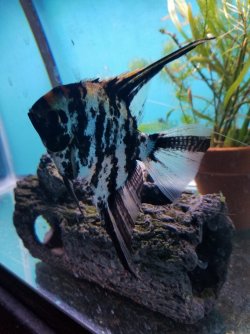After you suggested it, I did look into its use for fin rot and found a couple promising anecdotes. I think I'll give it a shot after a week or so of daily water changes once the antibiotic treatment is done. I'll try it without a fin snip at first, since I'm not confident in my ability to get a clean cut. I assume that would simply involve cutting away the damaged tissue, yes? I'd worry about getting good margins too, with the rot creeping up on the peduncle like it is. However, if the betadine doesn't work on its own, I'm willing to try my best for this little guy.Betadine isn't commonly used for fish. It was suggested to me for an injury to a red eared slider turtle many years ago, and she recovered. I had read of iodine being used by 1930s aquarists, and I have tried it on a couple of infected wounds on fish with success. I keep it out of the eye and gill area, and use it on caudals, mainly.
What's off with your neon is he is alone in this. Usually Flavibacter starts showing up on other fish.
Is it a one off treatment? It may do nothing, it may work once, it may need several treatments. It's a suggestion I'd use in desperation to keep that pathogen from reaching the peduncle. Is it bacterial or fungal? I can't say, but it looks largely unaffected by a good antibiotic mix.
I'd even consider a fin snip and something topical.
There's a class on fishes happening at my institution right now, and I know the TA. They've been using an anesthetic for fish, which I could almost certainly nip a few milligrams of. The handy thing about working at a scientific institution is that I have access to very precise scales. So, it's not out of the realm of possibility for me to be able to anesthetize and get a better fin snip that way.
That said, the reason I would want to wait until after a week or so of daily water changes is because I noticed what looks to potentially be some regrowth this morning. I'm trying not to get my hopes up, but if he can fight off the rest of whatever is going on with the help of really clean water, then that would be great.
The trouble with fin rot is that it can be caused by a whole suite of different bacteria. Most off-the-shelf fish antibiotics claim to cure fin rot, and they probably aren't lying (technically) because there's always a chance that you get lucky and match a drug to the bacteria it targets. It's frustrating that culturing and sensitivity testing isn't available or is cost-prohibitive for most hobbyists, because that's what's needed for most cases of fin rot. Overall, though, most bacterial infections in fish are gram-negative, so something like erythromycin probably isn't going to be very effective. I will keep it in mind, but I also don't want to "shotgun" antibiotics. I've already employed three (albeit with a long break between the first and second two), and "shotgunning" is a great way to build antibiotic resistance.I would try one dose of Maracyn (erythromycin) and wait a week. Erythromycin cures tail rot too and primarily attacks gram-positive bacteria. Kanamycin attacks primarily gram-negative bacteria. I have used both antibiotics when one didn't work and then the other succeeded.



